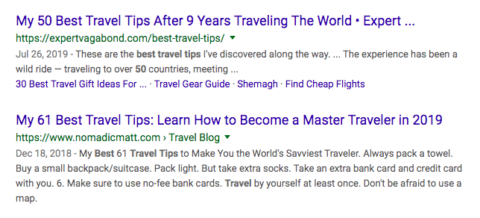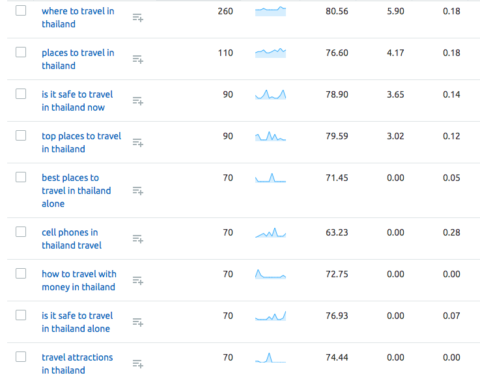Anyone who takes a deep dive into the world of SEO content creation knows that there are many, many factors at play when it comes to making content search-friendly and click-worthy.
From choosing the right keywords, to conducting audience research, to writing engaging titles, it can be a long, painstaking process to create content that outranks your top-ranking competitors.
This desire to create bigger and better content has led to this often cringe-worthy trend: turning every article into an “ultimate guide”.
Is There Such a Thing as an ‘Ultimate’ Guide?
“Ultimate guide” implies that your content is the best, right? That no one else can top it. That it’s the blog post to end all blog posts.
The issue is that with so many articles claiming to be “ultimate guides”, throwing this into your post title has started to lose its meaning. Claiming that your article is the best doesn’t make it so.



If we remember that the purpose of your SEO content is to attract traffic and generate clicks, we’ll see that the magic of creating an “ultimate guide” is not in the title or even the length.
It’s in the value.
Here’s how to create a true ultimate guide – the right way – in order to attract more organic traffic and get readers raving about your content.
An Ultimate Guide Is More Than Just a Listicle

Many content creators and SEO professionals approach content with the belief that longer is better – despite the numerous studies that have shown diminishing returns on content that is too long.
There’s a sweet spot for every topic and niche, and simply adding more bullet points for “top tips” to your ultimate guide does not necessarily mean you are adding more value.
Your goal in creating an ultimate guide is to provide better information than all of the top-ranking posts for your chosen focus keyword.
You do that not by making it longer (necessarily), but by doing your research to determine what the existing articles offer that your guide has to have.
Step 1: Have a Purpose (Beyond Ranking)
I get it. It’s enticing to go after those sweet money keywords when you see an opportunity to outrank your competitors.
But beyond rankings, there’s typically the ultimate goal of getting readers to take action – by subscribing, by buying a project, or by filling out a form.
That’s why it’s short-sighted to create an ultimate guide for the sole purpose of targeting a particular keyword. Instead, it’s best to have a strategy that works to drive conversions through your content.
Before writing your ultimate guide, consider what action (if any) you want readers to take. Are you:
- Simply aiming to inform readers about a topic?
- Trying to build brand trust?
- Trying to generate subscribers or leads?
It’s essential that you know your end goal.
Having a clear objective in mind will help you determine what value you need to provide and how. It will keep you focused on writing content that serves to not only attract traffic but also make the most of that traffic.
When it comes to marketing content, its success should be measured in terms of the return on your investment (ROI). Writing with conversions in mind will help you get the ROI you are looking for – in the form of subscribers, phone calls, leads, and sales.
Step 2: Choose Your Keyword(s)

Not every keyword is suited for an ultimate guide.
Just because your goal is to provide more value than the content that’s already ranking, doesn’t mean throwing “ultimate guide” in front of it is the move. It may be better suited for a different type of content (like a standard blog post or a listicle).
“Ultimate guide”-type keywords are ones that warrant a well-thought-out, in-depth piece of content. They should be topics that necessarily require a comprehensive guide in order to leave readers feeling sufficiently informed.
Relatively broad topics are a great fit an ultimate guide because they require many sections, explanations, examples, and actionable steps.
“Best places to visit in Thailand” can be summed up in a relatively concise listicle. “How to travel in Thailand” leaves much more room for elaboration.
Consider whether an ultimate guide would do your chosen keyword justice, or whether a different type of content would be a better fit instead. Some things to consider are:
- What is the user intent behind the keyword?
- Could you answer the user’s primary question in a relatively short (or standard-sized) article?
- Can you effectively write a comprehensive guide about the topic without stuffing it full of fluff?
- Are there already tons of “ultimate guides” about this topic?
- Are you confident that you can at least offer 2X the value of the top-ranking articles?
In summary, choose keywords that warrant a comprehensive piece of content.
If you feel that in order to create an ultimate guide you’ll have to chock your content full of useless facts and tips, you should probably take a different approach.
Step 3: Scope out the Not-So-Ultimate Guides
Not all ultimate guides are created equal.
If you’ve decided that your focus keyword warrants an ultimate guide, then your next step should be to look at what’s already ranking. Chances are, you’ll find some existing “ultimate guides”.
In this step, you’ll want to look at what your competitors are doing right and wrong.
- Are they simply regurgitating the same-old information?
- Are they bringing anything unique to the table?
- How can you learn from them and make your content 2X better?
Since your competitors are ranking for that keyword, they must be doing something right.
Look for similarities and characteristics that you think may be giving them a competitive edge. Then, looks for gaps in information that you can fill with your ultimate guide.
Your ultimate guide – as the name implies – should aim to be the best of the best. That means capitalizing off of what your competitors are doing right and then making your content even better.
Step 4: Survey Your Audience
Want to know what your audience really wants to read? Ask them!
The best way to provide the most value in your ultimate guide is to ask your readers what they are interested in.
You can survey your audience casually (by asking them questions on social media) or by sending them an official survey (directly or via email). Their answers will help you determine what information to include in your guide.
Here are some questions you can ask your audience:
- What is your top struggle when it comes to dealing with [ topics/problem ]?
- What are three questions you have about [ topic ]?
- What do you wish other brands knew about [ topic ]?
- What are some solutions you have tried to solve [ problem ]?
- What’s your top tip when it comes to [ topic ]?
In SEO content, it’s best to avoid making guesses when you can get your answers straight from the source.
By asking your audience directly, you can be sure to write content that answers their most burning questions, thoroughly covers the topic, and provides the value that your particular audience is looking for.
Step 5: Include Case Studies, Examples & Statistics

Any claims that you make in your ultimate guide should be supported by case studies, examples, or statistics.
Including this information serves to provide value to your readers in a variety of ways:
Authority
Including sources shows your readers that you know what you are talking about.
In other words, it helps establish you as an authority on the topic.
Rather than making baseless claims, you can back up all of your information with facts.
Trust
Referencing sources helps build trust with your audience.
When people are confident that the information you are providing is accurate, they are more likely to buy from you.
Application
Including examples helps readers make the connection between the information in your ultimate guide and how they can apply it to their lives or businesses.
Examples prove that the tips or strategies you are sharing work and that by taking action readers can see similar results.
E-A-T
“E-A-T” is a principle in SEO that stands for Expertise, Authoritativeness, and Trustworthiness.
Google’s Danny Sullivan has suggested that the secret to better rankings is better content. And the key to better content? You can find that in the quality raters guidelines, which talks in great detail about E-A-T.
By including case studies, examples, and sources in your ultimate guide, you’ll indicate to search engines that your content is valuable, accurate, and comes from a reputable source.
Following this step is another way to provide value where your competitors may be coming up short.
Step 6: Make It Actionable
If you know the search intent behind the keyword you are targeting with your ultimate guide, then you should be able to make a guess about what users are trying to achieve by reading your content.
Most times, their goal is to get their most pressing questions answered. Why? Because they are likely experiencing an issue that needs fixing, or want to learn more about a topic.
Your best bet in creating your ultimate guide, then, is to make the information you provide actionable in some way. You want to do your very best to help them fix whatever problem they are experiencing and answer every question they may have.
If your ultimate guide is about “how to plan a honeymoon”, you’ll likely want to include tips like:
- Where and how to hire a travel planner.
- How to choose the best hotel.
- How to prepare for international travel.
- How to budget for a honeymoon.
- Best places to book affordable airfare.
Even better, these actionable steps all provide an opportunity for you to link to other related content on your site. Either way, you are giving the readers the information they need to apply your tips to their lives.
Not only will making it actionable put your guide miles above competing articles, but it’ll make it more likely that your guide will drive conversions.
If you are able to offer all of the information they need on your site, it’ll be easy to direct them to your products and done-for-you services.
Step 7: Make It Pretty
Creating an ultimate guide takes time – and, often, money. To truly make an “ultimate” guide, you won’t want to cut corners.
Make the most of the work and resources you are putting in by making your guide attractive and eye-catching, as well as informative. It’ll be worth it to employ a graphic designer and/or web developer to create a sleek, on-brand looking guide.
Including various types of media – like videos, infographics, and images – will also help you repurpose your content across multiple platforms. You can build out an entire content marketing strategy from a single piece of content.
Further, engaging graphics will make your guide more memorable and likely to be shared by readers. You can capitalize on this momentum to generate even more traffic and, hopefully, leads.
Step 8: Add a Content Upgrade
Assuming your content is optimized to the nines and starts generating organic traffic, you’ll also want to be sure you are making the most of that traffic.
Beyond including links to your product pages or adding calls-to-action, you can incorporate a content upgrade to get readers to join your email list.
Content upgrades work great because they entice readers with even more valuable content than what you are already offering in your ultimate guide. If the upgrade is irresistible, users will hand over their email addresses in exchange for more juicy content.
Some possible content upgrade ideas include:
- A free downloadable ebook.
- A link to an exclusive expert interview.
- A free sign-up for a 5-day email course.
- A discount code for a paid product.
- An expanded ultimate guide (e.g. “Get the rest of the tips here!”).
- A free design or strategy template.
By adding a content upgrade to your ultimate guide, you can capture some of that traffic coming in and remarket to them later.
You’re essentially giving users multiple ways to opt-in (convert) – ensuring that you are making the absolute most of the traffic your content is generating.
Examples of Ultimate Guides That Get It Right
If you want to create the ultimate “ultimate guide”, it’s recommended that you learn from those that are already doing it right.
After following the tips above, look to some of these examples to find ways to make your guide even better.
- Ultimate Guide to Enterprise SEO
- Ultimate Guide to SEO-Friendly URLs
- Ultimate Guide to “LinkedIn Today”
- Ultimate Guide to SEO in 2019
Create Your Ultimate ‘Ultimate Guide’
Think you have what it takes to create a true “ultimate guide”?
Remember that your primary objective is to provide even more value than what’s already ranking.
Do that, and you’ll have a good chance of not only rising above your competitors but also converting readers into genuine leads.
Simply calling your guide an “ultimate guide” isn’t enough.
Follow the steps above in order to target the best keyword, create content your audience truly wants to read and provide accurate, actionable information that grabs users’ (and Google’s) attention.
More Resources:
- 9 Tips for Creating Your Best SEO Content This Year
- Content Marketing: The 5 Most Important Things You Need to Know
- Want to Rank #1? 6 Tips to Create SEO-Friendly Content
Image Credits
In-Post Image: Pexels
All screenshots taken by author, August 2019





